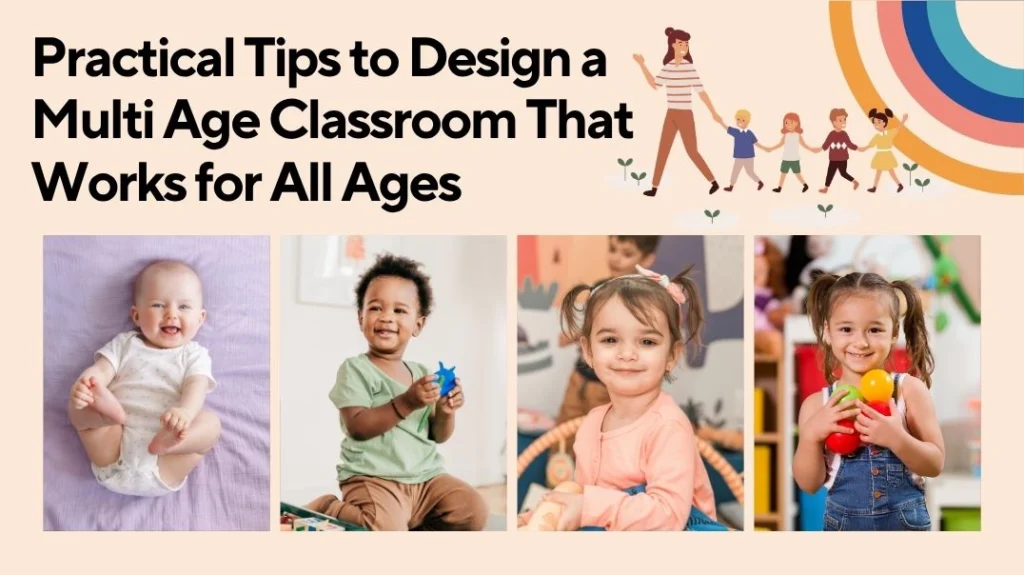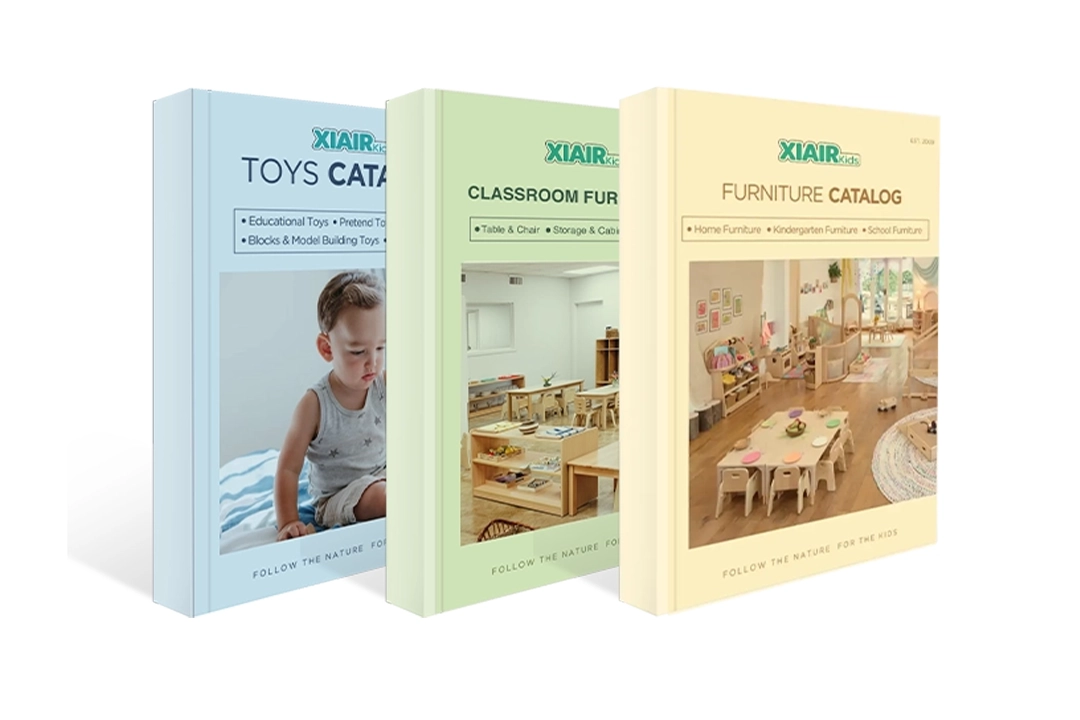الفصول الدراسية متعددة الأعمار ليست مجرد توجه، بل هي حلٌّ للحاجة المتزايدة لبيئات تعليمية شاملة ومرنة في رياض الأطفال ودور الحضانة. فبدلاً من تقسيم الأطفال حسب أعمارهم فقط، تُصنّف هذه الفصول الدراسية الأطفال حسب استعدادهم واهتماماتهم وتطورهم الاجتماعي. والنتيجة؟ يطور الأطفال الأكبر سنًا مهارات القيادة، ويتعلم الأطفال الأصغر سنًا من خلال محاكاة أقرانهم، ويستفيد الجميع من تجربة تعليمية تعاونية وواقعية.
لكن إنشاء فصل دراسي ناجح متعدد الأعمار لا يأتي صدفة. بل يتطلب تخطيطًا مدروسًا، وفهمًا عميقًا لكيفية تفاعل الفئات العمرية المختلفة، وخيارات تصميمية تعزز الاستقلالية والإبداع والسلامة. كل قطعة أثاث، وكل رف، وكل زاوية يجب أن تناسب أكثر من عمر واحد، وأن تتكيف مع نمو الأطفال.
في هذا الدليل الشامل، ستجد استراتيجيات عملية ومفصلة لإنشاء صف دراسي فعال ومتعدد الأعمار. سنستكشف تصميم الصف، واختيار الأثاث، وتقسيم الأنشطة، وحلول التخزين، والتصميم الملائم للسلوك، مع مراعاة القيود الواقعية. سواء كنت تبدأ من الصفر أو تُحسّن مساحتك الحالية، ستساعدك هذه النصائح على إنشاء صف دراسي يدعم كل طفل يوميًا.
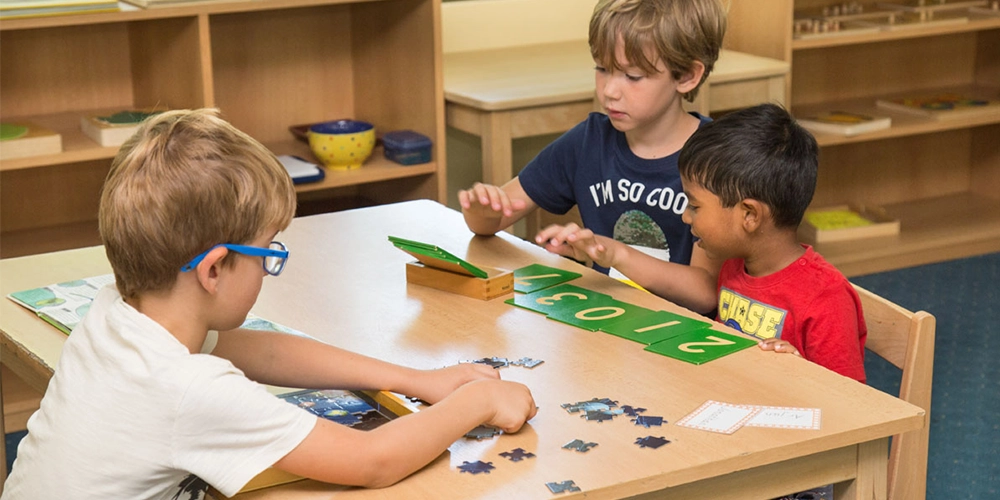
مقدمة
الفصول الدراسية متعددة الأعمار تتطلب هذه الأنشطة أكثر من مجرد نوايا حسنة، بل تتطلب هيكلًا واضحًا، وتصميمًا قابلًا للتكيف، ومرونة يومية. ستجد في الأقسام استراتيجيات مفصلة لتجهيز مساحتك، واختيار أثاث يناسب فئات عمرية متعددة، وتنظيم مناطق تعلم تدعم الاستقلالية والتعاون.
هذه ليست نظرية، بل دليل عملي يمكنك استخدامه لتصميم صف دراسي يتطور مع طلابك.
فهم مفهوم الفصول الدراسية متعددة الأعمار
ما هو الفصل الدراسي متعدد الأعمار؟
يجمع الفصل الدراسي متعدد الأعمار في رياض الأطفال أطفالًا من مختلف الفئات العمرية - عادةً من سنتين إلى ست سنوات - في بيئة مشتركة مصممة بعناية. بخلاف الفصول الدراسية التقليدية التي تُصنّف الأطفال حسب فئات عمرية محددة، تُعطي الفصول الدراسية متعددة الأعمار الأولوية لمرحلة نمو الطفل، وليس فقط لرقم كعكة عيد ميلاده.
في هذه المساحة، قد يكون طفل في الثانية من عمره يُكدّس المكعبات بالقرب منه، بينما ينغمس طفل في الرابعة من عمره في اللعب التخيلي، ويساعد طفل في الخامسة صديقه في حل أحجية. الغرفة ليست مُقسّمة حسب العمر، بل هي متصلة بالفضول والتفاعل، ومواد مختارة بعناية تدعم مجموعة واسعة من القدرات.
والنتيجة بيئة مرنة أشبه بالعائلة، حيث يكون كل طفل متعلمًا ومساهمًا. يراقب الأطفال الأصغر سنًا ويتعلمون من أقرانهم الأكبر سنًا، بينما يكتسب الأطفال الأكبر سنًا الثقة والقيادة من خلال دعم من هم في بداية حياتهم.
كيف تعمل الفصول الدراسية متعددة الأعمار في مرحلة ما قبل المدرسة
في فصول ما قبل المدرسة متعددة الأعمار، لا يقف المعلم أمام الجميع ليُلقي الدرس نفسه. بل يتم التعلم في مجموعات صغيرة، ومراكز تفاعلية، ولقاءات فردية. بناءً على اهتمام الأطفال واستعدادهم، قد يتنقلون بين مناطق الأنشطة، مثل طاولة الحواس، أو ركن اللعب الدرامي، أو ركن القراءة الهادئة.
دور المعلم أشبه بدور المُيسِّر أو المرشد. فهو يُراقب كل طفل، ويُقدِّم له مواد جديدة في الوقت المناسب، ويُعزِّز التفاعلات الاجتماعية بلطف. لا يُطلب منه "مواكبة" أو "التباطؤ". يتبع كل طفل وتيرته الخاصة ضمن إيقاع مُشترك.
الأنشطة مفتوحة، وتُختار المواد لتناسب مختلف مستويات المهارة. على سبيل المثال، تُعدّ المكعبات الخشبية بسيطة بما يكفي ليستكشفها الأطفال الصغار، ومعقدة بما يكفي ليتمكن الأطفال الأكبر سنًا من بناء هياكل مفصلة. الكتب، واللوازم الفنية، والألغاز مُتاحة ومتنوعة، ليجد كل طفل ما يناسبه.
فصول ما قبل المدرسة متعددة الأعمار مقابل الفصول الدراسية المختلطة مقابل الفصول الدراسية التقليدية
على الرغم من أن هذه المصطلحات تُستخدم عادةً بالتبادل، إلا أن هناك اختلافات كبيرة في كيفية هيكلة كل نوع من أنواع الفصول الدراسية وتشغيلها.
فيما يلي مقارنة جنبًا إلى جنب للمساعدة في التوضيح:
| وجه | فصول دراسية متعددة الأعمار | فصول دراسية مختلطة الأعمار | الفصول الدراسية التقليدية |
|---|---|---|---|
| التصنيف العمري | التجميع المتعمد على مدى 2-3 سنوات (على سبيل المثال، 3-6) | مجمعة على أساس التسجيل أو التوظيف | نطاق عمري ضيق (عادةً سنة واحدة) |
| فلسفة | يعتمد على التنمية ويركز على التعلم من الأقران | التجمع العملي أو اللوجستي، وليس دائمًا مدفوعًا بالفلسفة | استنادًا إلى معايير عمرية موحدة |
| تصميم المناهج الدراسية | مرنة، مفتوحة، فردية | غالبًا ما تكون موحدة، مع تعديلات طفيفة | محتوى مستوى الصف، هو نفسه للجميع |
| دور المعلم | مُيسِّر، مراقب، مُتكيف مع كل طفل | مدرس أو مدير بمستويات مختلفة | التعليم المباشر، التدريس الموحد |
| التفاعل بين الأقران | تم تشجيعها وتنظيمها عبر خطوط العمر | قد يتم أخذ الفجوات العمرية غير المنظمة في الاعتبار أو قد لا يتم أخذها في الاعتبار | في الغالب بين أقران من نفس العمر |
| الاستمرارية | غالبًا ما تكون متعددة السنوات (يبقى الأطفال مع نفس المعلم/الفصل) | عادة ما تكون مدتها سنة واحدة | سنة واحدة، ثم الانتقال إلى فصل جديد ومعلم جديد |
| الفضاء والمواد | مصممة لمجموعة واسعة من الاحتياجات والقدرات | قد يفتقر إلى مواد متنوعة من حيث النمو | المعدات والألعاب المخصصة لكل عمر |
تسلط هذه المقارنة الضوء على كيفية تميز الفصول الدراسية متعددة الأعمار من حيث البنية والهدف والمرونة والقيمة التنموية.
الميزات الأساسية لفصول ما قبل المدرسة متعددة الأعمار
لا يقتصر نجاح الفصول الدراسية متعددة الأعمار لمرحلة ما قبل المدرسة على دمج الفئات العمرية المختلفة، بل يشمل أيضًا تصميم بيئة تفاعلية وتفاعلية تُعزز نمو كل طفل من خلال تخطيط مدروس.
وفيما يلي الميزات الأساسية التي تحدد هذا النموذج - كل منها مصمم بعناية لتلبية احتياجات الطفولة المبكرة:
1. التجمعات العمرية المختلطة (فترة تتراوح من سنتين إلى ثلاث سنوات)
تتراوح أعمار الأطفال في الفصول الدراسية متعددة الأعمار عادةً بين سنتين وست سنوات. تتيح هذه المرحلة العمرية للأطفال الأصغر سنًا التعلم من أقرانهم الأكبر سنًا، بينما يُعزز الأطفال الأكبر سنًا معارفهم من خلال توجيه الآخرين. تُعدّ الفوائد الاجتماعية والمعرفية لهذا التنوع العمري أساسية لكيفية عمل الفصل الدراسي.
2. روتينات مفتوحة ومرنة
لا يُقسّم الجدول اليومي إلى فترات زمنية محددة، بل يشمل فترات طويلة من اللعب المتواصل والاستكشاف والتفاعل ضمن مجموعات صغيرة. يتنقل الأطفال بين الأنشطة بناءً على استعدادهم واهتماماتهم، لا بناءً على أعمارهم أو الوقت المخصص لهم.
3. فرص التعلم بين الأقران
غالبًا ما يساعد الأطفال الأكبر سنًا في مرحلة ما قبل المدرسة زملاءهم الأصغر سنًا في التنظيف أو سرد القصص أو بناء المكعبات. هذه التفاعلات طبيعية وليست مفروضة، وتساعد كلا المجموعتين على بناء التعاطف والتواصل والثقة. ويحل نموذج الأقران محل التعليم التنازلي في كثير من الأحيان.
4. مواد متمايزة وأدوات متعددة المستويات
يحتوي الفصل الدراسي المجهز جيدًا والمتنوع الأعمار على ألعاب وكتب وألغاز ولوازم فنية تناسب مختلف مراحل النمو. على سبيل المثال، قد يحتوي رف واحد على ألغاز كبيرة ذات مقابض للأطفال الصغار، وألغاز متشابكة أكثر تعقيدًا للأطفال الأكبر سنًا. لا يُستبعد أي طفل لأن المواد بسيطة جدًا أو معقدة.
5. العلاقات طويلة الأمد واستمرارية المعلم
غالبًا ما يبقى الأطفال مع نفس المعلم أو فريق التدريس لأكثر من عام. تساعد هذه الفترة الزمنية الطويلة المعلمين على فهم نقاط قوة كل طفل وتحدياته وأسلوب تعلمه بشكل أفضل. يصبح الفصل الدراسي مساحة مستقرة وقابلة للتنبؤ، وهو أمر أساسي للنمو العاطفي للأطفال الصغار.
6. احترام وتيرة الفرد
لا يُقاس التقدم بنمو الأطفال الآخرين، بل بنمو كل طفل. لا يوجد هنا "أطفال متأخرو النمو"، بل أطفال يتعلمون بطريقتهم الخاصة، وفقًا لجدولهم الزمني الخاص. هذا النهج يُخفف القلق ويُعزز الدافعية الذاتية.
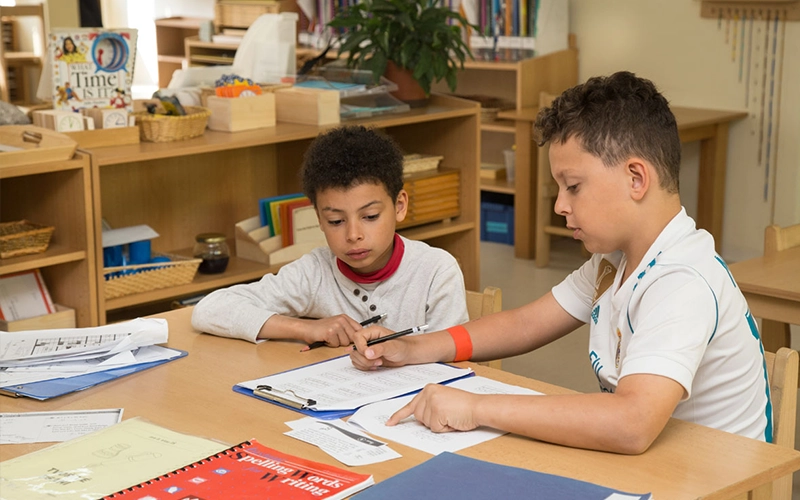
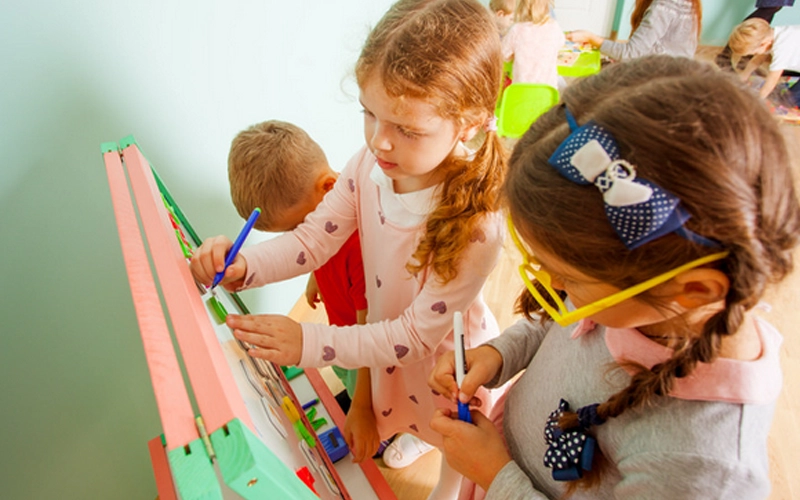
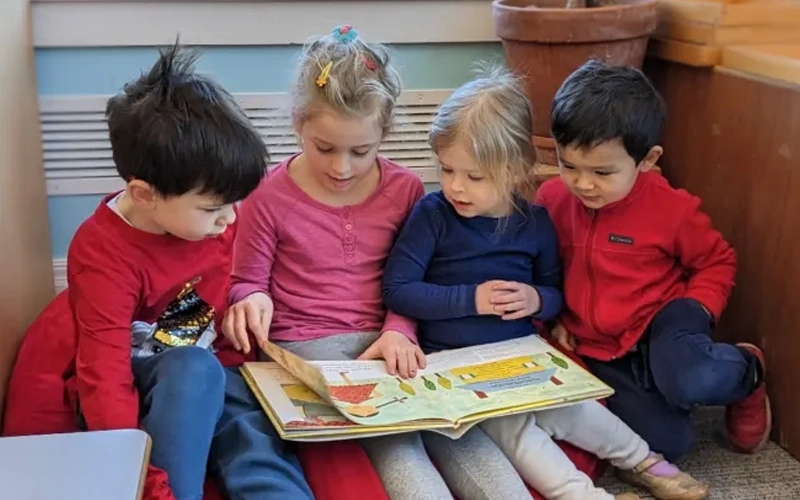
الأساس التربوي والاتجاهات العالمية
الفلسفة التربوية وراء الفصول الدراسية متعددة الأعمار
يرتكز نموذج الفصول الدراسية متعددة الأعمار على الاعتقاد بأن الأطفال يتعلمون بشكل أفضل في بيئات تعكس العالم الحقيقي، حيث يتعلم الأشخاص من مختلف الأعمار ويعملون وينمون معًا. يُحوّل هذا النهج التركيز من التعليم القائم على العمر إلى الممارسة المناسبة للنمو.
بدلاً من توقع تحقيق كل طفل للمراحل التعليمية نفسها في آنٍ واحد، تُراعي الفصول الدراسية متعددة الأعمار الاستعداد الفردي. لا يُطلب من الأطفال اللحاق بالركب أو انتظار الآخرين. يتعلمون بالممارسة والملاحظة والاستكشاف والتفاعل مع الكبار والمواد، والأهم من ذلك، مع بعضهم البعض.
يدعم هذا الهيكل أساليب تعلم متنوعة، ويتيح للمعلمين الالتقاء بالأطفال أينما كانوا. كما يعزز شعورًا أعمق بالانتماء للمجتمع، حيث يتولى الأطفال الأكبر سنًا أدوارًا قيادية بشكل طبيعي، ويتأثر الأطفال الأصغر سنًا بما يشاهدون أقرانهم يفعلونه.
مونتيسوري ومنهج التعليم متعدد الأعمار
يُعدّ منهج مونتيسوري من أكثر الأمثلة هيكلةً ودراسةً على نطاق واسع للتعلم متعدد الأعمار في مرحلة الطفولة المبكرة. فهو لا يسمح فقط بدمج الأطفال في مجموعات عمرية مختلفة، بل يعتمد على ذلك. صُممت فصول مونتيسوري عمدًا لتشمل فئات عمرية تتراوح بين ثلاث سنوات، وغالبًا ما تتراوح بين ثلاث وست سنوات، وهو ما يتوافق تمامًا مع مرحلة ما قبل المدرسة.
في فصول مونتيسوري متعددة الأعمار، يختار الأطفال أنشطتهم من مجموعة مواد مُختارة بعناية. تُرتب هذه المواد على أرفف مفتوحة، في متناول اليد، وتتميز بخاصية التصحيح الذاتي، ما يعني أن الأطفال يستطيعون استخدامها بشكل مستقل دون تدخل مستمر من الكبار. يشجع هذا التصميم على الاستقلالية والاستكشاف والنمو الذاتي.
الاستخدام المدروس للبيئة يجعل نموذج مونتيسوري فعالاً في البيئات متعددة الأعمار. تنقسم مناطق الفصول الدراسية إلى أنشطة عملية، واستكشاف حسي، ورياضيات، ولغوية، وثقافية. هذه المناطق متاحة لجميع الأعمار، لكن تفاعل الأطفال معها يختلف باختلاف مرحلة نموهم. على سبيل المثال، قد يستكشف الطفل الأصغر سنًا سكب الماء باستخدام الفاصوليا والمغارف، بينما يعمل الطفل الأكبر سنًا على قياس السوائل باستخدام نفس نوع المادة.
في بيئة مونتيسوري، يعمل المعلمون كمرشدين أكثر منهم كمعلمين. يراقبون اهتمامات كل طفل واحتياجاته التنموية عن كثب، ولا يتدخلون إلا عند الضرورة. يقدمون المواد التعليمية عندما يُظهر الطفل استعداده، وليس بناءً على جدول زمني. كما أن التعلم من الأقران أساسي: فالأطفال الأكبر سنًا يُظهرون تقليدًا طبيعيًا للسلوك والروتين وحل المشكلات دون حث.
يدعم هذا النموذج الفصول الدراسية متعددة الأعمار بما يتماشى تمامًا مع أهداف مرحلة ما قبل المدرسة. فهو يُدرك أن الأطفال ينمون على دفعات، لا تدريجيًا، وأن وجود متعلمين أصغر سنًا وكبارًا في نفس المكان يُتيح فرصًا أكبر للنمو، لا مزيدًا من التعقيدات.
يعمل نهج مونتيسوري متعدد الأعمار على تعزيز النظام والاستقلال والتعلم الاجتماعي ويوفر إطارًا واضحًا لتصميم الفصول الدراسية التي تدعم التنمية الحقيقية، وليس فقط الاستعداد الأكاديمي.
لماذا ينجح هذا النموذج مع الأطفال في مرحلة ما قبل المدرسة
يتعلم أطفال ما قبل المدرسة بالممارسة والمشاهدة واللمس والتكرار. فهم مُهيأون للتجارب العملية والتفاعلات الاجتماعية، لا للتعليم السلبي. ولهذا السبب تحديدًا، يُناسب الفصل الدراسي متعدد الأعمار هذه المرحلة من النمو.
في أحد الأيام، قد ترى طفلًا أصغر سنًا يراقب بهدوء كيف يستخدم زميله الأكبر سنًا ملقطًا لفرز الكرات الملونة في أكواب. بعد عشر دقائق، يحاول الطفل الأصغر نفسه القيام بذلك بمفرده، مُنمّيًا مهاراته الحركية الدقيقة دون أن يُدرك ذلك. في زاوية أخرى، قد يتفاوض طفلان أكبر سنًا في مرحلة ما قبل المدرسة على من سيصبح "الطاهي" في المطبخ التخيلي - وهي فرصة طبيعية لتنمية مهارات اللغة والصبر وتبادل الأدوار.
هذه التفاعلات المباشرة بين مختلف الأعمار مؤثرة. يتعلم الأطفال الأصغر سنًا بالتقليد، بينما ينمو الأطفال الأكبر سنًا من خلال القيادة. تستفيد كلتا المجموعتين من التواجد في بيئة تُقدّر دورهم، لا مجرد أعمارهم.
من وجهة نظر المعلم، يُسهم الفصل الدراسي متعدد الأعمار أيضًا في إدارة السلوك. فالأطفال الذين قضوا وقتًا أطول في الفصل يفهمون الروتينات ويساعدون في صياغة التوقعات. هذا التناسق بين الأقران يُقلل من وقت المعلمين في إدارة الانتقالات أو تكرار التعليمات. بدلًا من ذلك، تُصبح ثقافة الفصل راسخة، مما يُسهّل على الطلاب الجدد التكيف، ويُعزز استقلالية الطلاب العائدين.
من الناحية العاطفية، تميل البيئات متعددة الأعمار إلى أن تكون أكثر رعاية. فمع قلة المقارنة والمنافسة، يشعر الأطفال بالأمان في المخاطرة، وتجربة مهام جديدة، وطلب المساعدة. فالبيئة لا تركز على من يتقدم، بل على كيفية نمونا معًا.
لأطفال ما قبل المدرسة الذين يطورون هوياتهم ومهاراتهم الاجتماعية وضبط أنفسهم، توفر هذه المساحة المرونة والأمان العاطفي الذي هم بأمسّ الحاجة إليه. فهي تساعدهم على بناء أساس للتعلم الشخصي والمشترك بوتيرتهم الخاصة، محاطين بأقران متشابهين ومختلفين.
الصعود العالمي لفصول ما قبل المدرسة متعددة الأعمار
على الرغم من أن نموذج الفصل الدراسي متعدد الأعمار يرتبط غالبًا بتعليم مونتيسوري، إلا أنه يتم اعتماده على نطاق واسع في العديد من بيئات التعلم المبكر.
في مدارس ما قبل المدرسة ودور الحضانة في جميع أنحاء أمريكا الشمالية وأوروبا وآسيا، يستكشف المعلمون التجميع المختلط الأعمار كحل لما يلي:
- أرقام التسجيل غير المتسقة
- مستويات الاستعداد المتنوعة بين الأطفال في نفس العمر
- الحاجة إلى تعزيز التعلم بين الأقران والترابط المجتمعي
تتضمن البرامج المستوحاة من ريجيو إميليا، ومدارس الغابات، والتعلم القائم على الاستقصاء، مرونةً في التعامل مع الفئات العمرية كجزء أساسي من تصميمها. تُدرك هذه المناهج أن التعلم لا يسير دائمًا على مسار مستقيم، وأن الفصول الدراسية ينبغي أن تعكس ذلك.
سواءً أكان الدافع فلسفيًا أم عمليًا، فإن التوجه نحو نظام التعليم متعدد الأعمار آخذ في الازدياد. فهو يوفر سبيلًا لإنشاء فصول دراسية أكثر شمولًا ومرونة، قادرة على تلبية الاحتياجات المتغيرة لأطفال مرحلة الطفولة المبكرة اليوم.
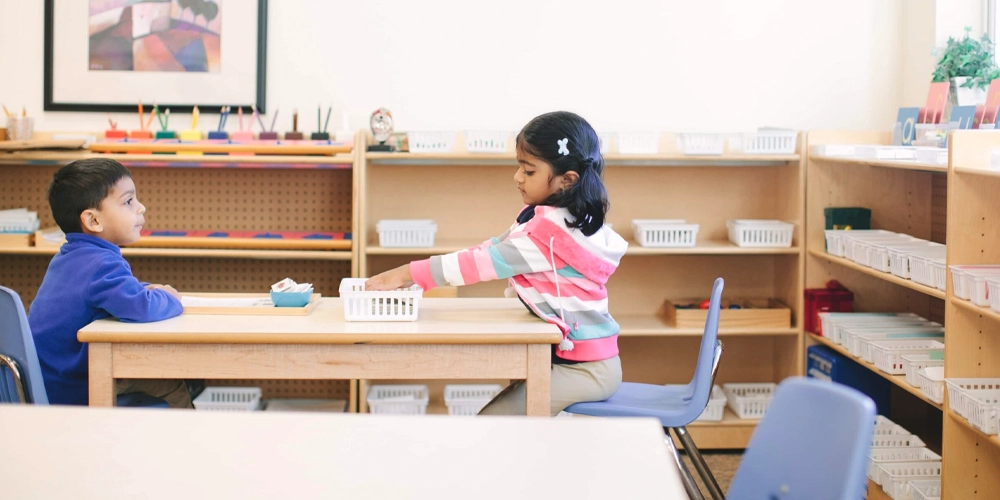
الفوائد والتحديات الأساسية للفصول الدراسية متعددة الأعمار
مزايا الفصول الدراسية متعددة الأعمار
يوفر الفصل الدراسي متعدد الأعمار مزايا فريدة عديدة تتوافق تمامًا مع احتياجات نمو أطفال ما قبل المدرسة. وتمتد هذه المزايا لتشمل الأطفال والمعلمين وحتى العائلات.
- 1. التعلم بين الأقران والقيادة
في بيئة تعليمية مختلطة الأعمار، يتعلم الأطفال من بعضهم البعض بشكل طبيعي. يلاحظ الأطفال الأصغر سنًا كيفية استخدام أقرانهم الأكبر سنًا للمواد، وتحدثهم مع المعلمين، وحلهم للمشكلات، واتباعهم للروتين. هذا التفاعل يُساعدهم على تطوير مهاراتهم بشكل أسرع مقارنةً بالفصول الدراسية المعزولة حسب العمر.
في الوقت نفسه، يكتسب الأطفال الأكبر سنًا الثقة والنضج من خلال مساعدة زملائهم الأصغر سنًا. وهذا يُنمّي مهارات القيادة والتعاطف والصبر، وهي مهارات تُفيدهم جيدًا في البيئات الأكاديمية والاجتماعية اللاحقة. - 2. وتيرة التعلم الفردية
ينمو الأطفال بسرعات مختلفة، خاصةً خلال سنوات ما قبل المدرسة. في الفصول الدراسية متعددة الأعمار، يقل الضغط على "اللحاق" أو "التباطؤ". يراقب المعلمون كل طفل ويدعمونه بناءً على مستواه، وليس بناءً على ما ينص عليه المنهج الدراسي.
يسمح هذا النموذج بالتقدم الطبيعي في اللغة والمهارات الحركية والتطور الاجتماعي، مما يفسح المجال لكل من المزدهرين في وقت مبكر والمتأخرين في البدء. - 3. مجتمع صف دراسي أقوى
لأن الطلاب غالبًا ما يبقون في الفصل نفسه لسنوات عديدة، فإنهم يكتسبون شعورًا عميقًا بالانتماء. فالألفة مع أقرانهم، والروتين، والمساحة المادية تُولّد لديهم شعورًا بالأمن العاطفي.
هذا الشعور بالاستمرارية يفيد الأطفال الذين قد يواجهون صعوبات في الانتقال من مرحلة لأخرى. كما أنه يساعد المعلمين على بناء علاقات أقوى وأكثر وعيًا مع عائلاتهم مع مرور الوقت. - 4. بيئة أكثر ديناميكية وجاذبية
تميل الفصول الدراسية متعددة الأعمار إلى أن تكون أكثر مرونة وإبداعًا. يمكن تصميم الأنشطة لتشمل مستويات صعوبة متعددة. على سبيل المثال، قد يركز الأطفال الأصغر سنًا على اللون والملمس أثناء مشروع فني، بينما يستكشف الأطفال الأكبر سنًا الأنماط أو سرد القصص.
هذا النهج متعدد الطبقات يجعل التعلم أكثر جاذبية ويمكن الوصول إليه للجميع.
عيوب الفصول الدراسية متعددة الأعمار
وفي حين أن نموذج التعليم متعدد الأعمار يوفر العديد من نقاط القوة، فإنه يطرح أيضاً تحديات يتعين على المعلمين والإداريين الاستعداد لمواجهتها.
- 1. إعداد وتدريب المعلمين
يتطلب إدارة صف دراسي بهذا النطاق التنموي الواسع مهارةً وخبرةً. يجب أن يكون المعلمون قادرين على الملاحظة والتقييم والتكيف فورًا. غالبًا ما يتطلب هذا المستوى من التدريس التفاعلي تدريبًا إضافيًا، خاصةً للمبتدئين في مجال تعليم الطفولة المبكرة. - 2. تخطيط المناهج الدراسية قد يكون معقدًا
يُعدّ وضع خطط دروس تناسب مختلف الفئات العمرية أمرًا أكثر صعوبة. يجب أن تكون الأنشطة قابلة للتكيف، وأن تدعم مواد التعلم مهارات متنوعة. فبدون تخطيط مناسب، قد يشعر بعض الأطفال بالملل، بينما يشعر آخرون بالإرهاق. - 3. موازنة ديناميكيات المجموعة
يختلف الأطفال من مختلف الأعمار في مدى انتباههم واهتماماتهم ومستويات طاقتهم. قد يكون من الصعب الحفاظ على الانسجام في الفصل الدراسي عندما ترغب إحدى المجموعات في البناء بالمكعبات بينما تركز الأخرى على سرد القصص أو اللعب الهادئ.
بدون تقسيم واضح للفصول، قد تصبح المساحة فوضوية. يحتاج المعلمون إلى إدارة صفية فعّالة واستراتيجيات تخطيط مدروسة لضمان سير الأنشطة بسلاسة.
جدول ملخص الإيجابيات والسلبيات
فيما يلي نظرة سريعة على نقاط القوة الرئيسية والعيوب المحتملة للفصول الدراسية متعددة الأعمار في مرحلة ما قبل المدرسة:
| وجه | المزايا | العيوب |
|---|---|---|
| التفاعل بين الأقران | يشجع الإرشاد والقيادة والتعاطف | قد يسيطر الأطفال الأكبر سنًا دون توجيه |
| سرعة التعلم | يدعم التقدم الفردي | يتطلب تصميمًا مرنًا للمناهج الدراسية |
| البيئة الاجتماعية | بناء المجتمع والصداقات طويلة الأمد | قد تحتاج فجوات النضج الاجتماعي إلى اهتمام إضافي من المعلم |
| نهج التدريس | يتيح التدريس المستجيب القائم على الملاحظة | أصبح من الصعب توحيد التقييمات والنتائج |
| ثقافة الفصل الدراسي | يعزز التعاون على المنافسة | أصبح من الصعب توحيد التقييم والنتائج |
| المواد والتخطيط | تعزز المواد متعددة الاستخدامات الاستخدام الإبداعي عبر الأعمار | تحتاج المساحة إلى مزيد من التنظيم لتجنب الإفراط في التحفيز |

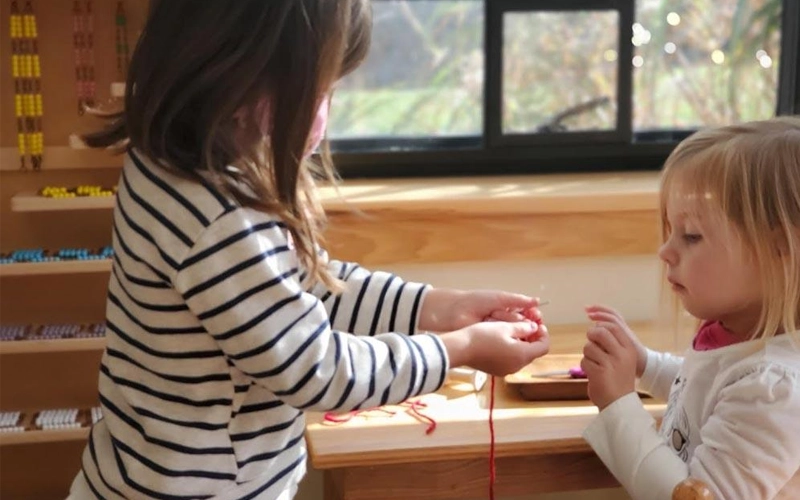
تفعيل الفصول الدراسية متعددة الأعمار في مرحلة ما قبل المدرسة ودور الحضانة
إيقاعات يومية مرنة تناسب الجميع
في فصول ما قبل المدرسة متعددة الأعمار، لا جدوى من وجود فترات زمنية صارمة وجداول دراسية محددة للمواد الدراسية. بدلاً من ذلك، الأفضل هو هيكل قائم على الإيقاع - روتينات متوقعة تمنح جميع الأطفال شعورًا بالاستقرار، مع مراعاة المرونة بناءً على العمر ومستويات الطاقة والاحتياجات الفردية.
بدلاً من قيام جميع الأطفال بنفس النشاط في آنٍ واحد، يُقسّم اليوم إلى لحظات مشتركة (مثل وقت الحلقات أو اللعب في الهواء الطلق) وفترات مفتوحة يتنقل فيها الأطفال بين مناطق الأنشطة بوتيرتهم الخاصة. يدعم هذا الإيقاع الأطفال في تنمية استقلاليتهم، ويُقلّل من فترات الانتقال، ويُتيح للمعلمين تقديم توجيهات أكثر تخصيصًا.
على سبيل المثال، خلال وقت المركز المفتوح، قد يستكشف طفل عمره سنتان ونصف عملية جمع وسكب الأشياء في الصندوق الحسي، بينما يكتب طفل عمره أربع سنوات ونصف اسمه باستخدام حروف مغناطيسية على طاولة قريبة. كلاهما يتعلم بمستويات مختلفة وفي نفس المكان.
إدارة الاحتياجات التنموية المتنوعة من خلال الهيكل
من أهم عناصر نجاح أي صف دراسي متعدد الأعمار هو كيفية التعامل مع مراحل النمو المختلفة. في الفصول الدراسية التقليدية، يُصنف الأطفال حسب أعمارهم، مما قد يُخفي استعداداتهم الفردية. وتتضح الفروقات بشكل أكبر في البيئات متعددة الأعمار، وكذلك الفرص المتاحة.
لدعم جميع المتعلمين:
- تم تصميم مناطق الفصول الدراسية بشكل مقصود- بدلاً من الفصل على أساس العمر، يتم تنظيم المساحة حسب نوع النشاط (القراءة الهادئة، اللعب الدرامي، البناء، وما إلى ذلك).
- المواد مقسمة حسب التعقيدليتمكن الأطفال الصغار من الاستكشاف بأمان بينما يواجه الأطفال الأكبر سنًا تحديات. على سبيل المثال، قد تحتوي زوايا الكتل على مكعبات إسفنجية كبيرة للأطفال الصغار، ومجموعات بناء معقدة للأطفال الأكبر سنًا في سن ما قبل المدرسة.
- نمذجة السلوك تحدث بشكل طبيعي- يلاحظ الأطفال الأصغر سنًا الروتين والعادات من أقرانهم، بينما يبني الأطفال الأكبر سنًا القيادة والصبر من خلال مساعدة الآخرين.
- التعليم في مجموعات صغيرة مرنغالبًا ما يعتمد ذلك على جاهزية المهارة لا على العمر. خلال حصص الفن، قد يتعلم بعض الأطفال كيفية إمساك الفرشاة، بينما يُبدع آخرون أعمالًا فنية مجمعة متعددة الخطوات - كل ذلك في البيئة نفسها، بتوجيه من المعلم نفسه.
يعزز هذا النهج الشمولية ويشجع التعلم الاجتماعي في الحياة الواقعية: تعلم كيفية التناوب، وحل النزاعات البسيطة، واحترام الاختلافات في القدرات والسلوك.
دور المعلم: المرشد والمراقب والميسر
في فصول ما قبل المدرسة متعددة الأعمار، يلعب المعلمون دورًا حيويًا ومتعدد الجوانب. تتجاوز مسؤولياتهم التدريس، فهم يراقبون باستمرار، ويكيفون، ويدعمون مجموعة متنوعة من الأطفال ذوي الاحتياجات المختلفة.
وهنا كيف يقوم المعلمون بتنفيذ الأمر:
- الملاحظة والتوثيق هي أمور محورية. يستخدم المعلمون ما يرونه - وليس فقط ما ينص عليه المنهج الدراسي - لتوجيه مسار تعلم كل طفل.
- التفاعل الاستجابي هذا هو المفتاح. قد يُوقف المعلم نشاطًا جماعيًا مؤقتًا لمساعدة طفل أصغر سنًا على تنظيم مشاعره، أو يُشجع طفلًا أكبر سنًا بهدوء على توجيه زميل له أثناء أداء مهمة.
- تشجيع الاستقلال هو هدف يومي. من اختيار الأنشطة إلى تنظيف الأدوات، كل مهمة هي فرصة للتعلم الذاتي.
- الحفاظ على الاستمرارية بناء الثقة عبر السنين. ولأن العديد من الأطفال يبقون مع نفس المعلم لمدة سنتين أو ثلاث سنوات، تتعمق علاقة المعلم بالطفل، مما يسمح بفهم أفضل ودعم أكثر ملاءمة.
هذا النوع من التدريس لا يتعلق بإدارة الفصل الدراسي، بل يتعلق بإدارة العلاقات والإيقاعات ومستويات الاستعداد داخل نفس المساحة.
كيفية تصميم مساحات التعلم المبكر للمجموعات العمرية المختلطة
أثاث مرن الذي يدعم الاختلافات التنموية
في فصول ما قبل المدرسة متعددة الأعمار، لا يقتصر الأثاث على الحجم فحسب، بل يشمل أيضًا الوظيفة، والقدرة على التكيف، والشمول. يساعد الأثاث المناسب على إدارة غرفة مليئة بالاحتياجات المتنوعة دون أن يشعر أي طفل بالتهميش أو الإهمال.
1. طاولات وكراسي قابلة للتعديل والتركيب
يختلف الأطفال الذين تتراوح أعمارهم بين سنتين ونصف وخمس سنوات اختلافًا كبيرًا في الطول ووضعية الجسم وتفاعلهم مع المواد. بدلًا من شراء مجموعات أثاث منفصلة لكل فئة عمرية، ابحث عن طاولات قابلة لتعديل الارتفاع وكراسي قابلة للتكديس تناسب مراحل نمو متعددة.
يمكن للطاولات المعيارية أيضًا أن:
- يتم تجميعهم للعمل التعاوني
- منفصلة للأنشطة الفردية الهادئة
- يمكن تحريكها بسهولة لفتح مساحة أرضية للأنشطة الحركية الكبرى أو وقت الدائرة
ويساهم هذا التكيف في دعم التطوير وتبسيط انتقالات الفصول الدراسية طوال اليوم.
2. أسطح عمل مشتركة على مستويات متنوعة
يجب أن توفر الغرفة التي تضم أعمارًا مختلطة ارتفاعات متعددة للطاولة:
- طاولات منخفضة للعب على الأرض أو للأطفال الصغار الذين يعملون على الألغاز
- محطات عمل ذات ارتفاع قياسي للأطفال الأكبر سنًا الذين يمارسون أنشطة الكتابة أو المهارات الحركية الدقيقة
- أسطح بارتفاع قائم للمهام الفنية الفوضوية أو العلمية العملية
يوفر هذا النهج الراحة الجسدية والتوافق التنموي دون فصل الفئات العمرية.
3. التخزين الذي يُعلّم المسؤولية
ويشمل الأثاث أيضًا أنظمة التخزين، وفي الفصول الدراسية متعددة الأعمار، يجب أن يكون تصميم هذه الأنظمة سهل الوصول إليه وغني بالمعلومات.
- تسمح الأرفف المفتوحة ذات الارتفاع المنخفض والمتوسط للأطفال باختيار العناصر وإرجاعها بشكل مستقل.
- تعمل العلامات المرئية (الرموز + الكلمات) على تعزيز معرفة القراءة والكتابة المبكرة مع المساعدة في التنظيم.
- تشجع العربات المتنقلة الاستخدام المرن للمواد عبر المناطق
يساعد التخزين الموضوع بشكل جيد على دعم سير العمل في الفصل الدراسي، ويعلم المسؤولية، ويقلل من التوتر المرتبط بالفوضى بالنسبة للأطفال والمعلمين.
4. السلامة أولاً، دائماً
اعتبارات السلامة في المجموعات العمرية المختلطة غير قابلة للنقاش. يجب أن يكون الأثاث:
- مدورة عند الحواف
- مستقرة ومقاومة للانقلاب
- مصنوعة من مواد غير سامة
- قادرة على التعامل مع الاستخدام اليومي المكثف
ابحث عن أثاث معتمد لمرحلة ما قبل المدرسة ومصمم خصيصًا لمراكز الرعاية النهارية والتعليم المبكر.
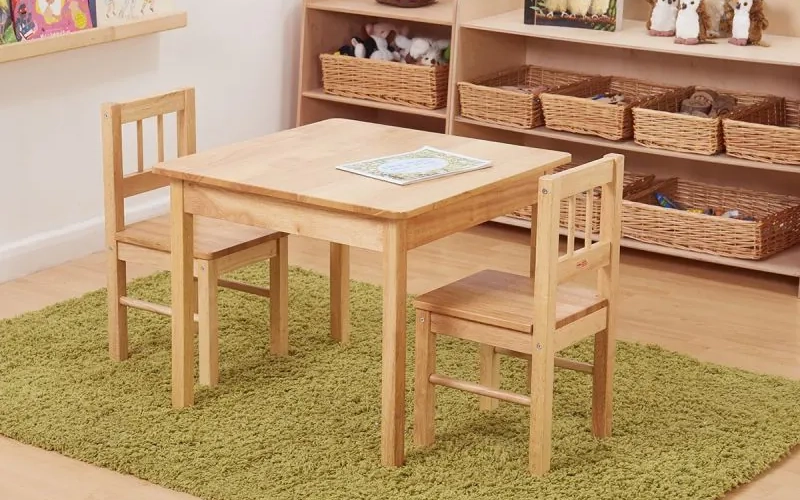
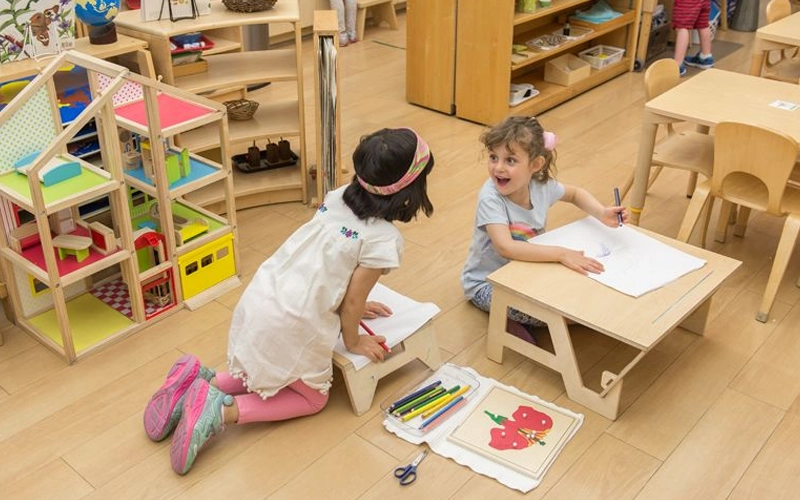
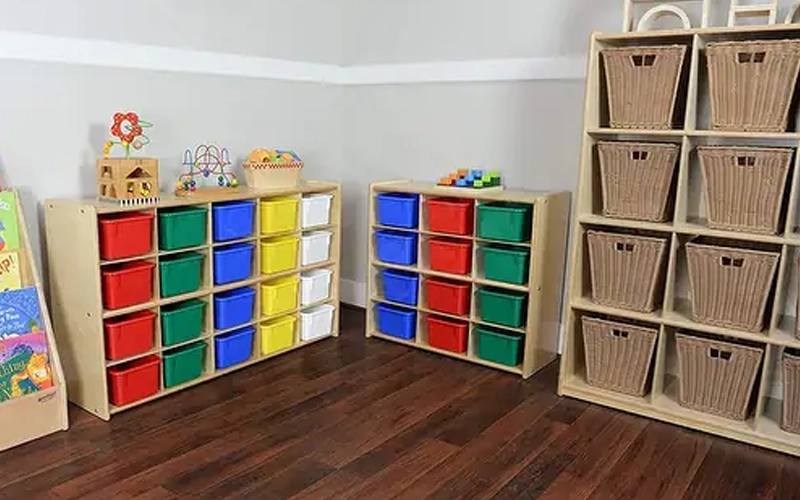
حلول تخزين ذكية للفصول الدراسية متعددة الأعمار
في فصول ما قبل المدرسة متعددة الأعمار، والتي تعمل بكفاءة، لا يقتصر التخزين على الحفاظ على الأشياء مرتبة فحسب، بل يدعم الاستقلالية والتنظيم والانتقال السلس للأطفال ذوي القدرات المختلفة. تُحدد طريقة تخزين المواد مدى قدرة الأطفال على الوصول إلى احتياجاتهم، ووضع الأشياء في أماكنها بشكل مستقل، والتحرك بثقة خلال اليوم الدراسي.
وفيما يلي أكثر استراتيجيات التخزين فعالية لبيئات التعلم المبكر متعددة الأعمار:
1. إمكانية الوصول متعددة الطبقات لجميع الأعمار
يختلف طول الأطفال الذين تتراوح أعمارهم بين سنتين وخمس سنوات اختلافًا كبيرًا، ومستويات التنسيق لديهم. ولذلك، يجمع التخزين المناسب بين مستويات طول متعددة:
- الرفوف السفلية (أقل من 60 سم) حتى يتمكن الأطفال الصغار من الوصول بسهولة إلى الألعاب والكتب والمواد الحسية
- أرفف متوسطة الارتفاع لتمكين الأطفال الأكبر سنًا في سن ما قبل المدرسة من الوصول إلى ألعاب أو مواد أكثر تعقيدًا بقطع أصغر
- تخزين على مستوى أعلى (بإدارة المعلم) للعناصر التي تتطلب إشرافًا، مثل المقص أو الطلاء أو مجموعات STEM
يضمن هذا الإعداد عدم استبعاد أي طفل بسبب القيود الجسدية مع تعزيز المسؤولية المناسبة للعمر.
2. مفتوح، مرئي، ومُسمّى بوضوح
عندما يتمكن الأطفال من رؤية المواد، يصبحون أكثر قدرة على استخدامها وإعادتها بشكل صحيح. الاستخدام:
- صناديق بلاستيكية شفافة للوازم الفنية والألعاب التفاعلية ومجموعات الألغاز
- ملصقات الصور مع النص لتعزيز معرفة القراءة والكتابة المبكرة والتعرف عليها
- مناطق مُرمَّزة بالألوان أو ملصقات أرفف (على سبيل المثال، اللون الأخضر للمكعبات، والأزرق للقراءة، والأصفر للفن) لإنشاء خريطة ذهنية للغرفة
تساعد هذه الأنظمة الأطفال على تطوير مهارات الوظائف التنفيذية مثل التصنيف والفرز وتذكر الروتينات.
3. التخزين المتنقل والوحدات النمطية
تستفيد الفصول الدراسية متعددة الأعمار بشكل كبير من الأثاث المتحرك. تتيح العربات المتنقلة والأرفف المتحركة للمعلمين ما يلي:
- جعل المواد أقرب إلى الأطفال الصغار
- إعادة تكوين الفصل الدراسي بسرعة للعمل الجماعي أو اللعب على الأرض أو التنظيف
- تكييف مواقع التخزين مع تطور المجموعة عبر الأشهر أو السنوات
يعد هذا المستوى من المرونة ضروريًا عندما يتشارك الأطفال الفصول الدراسية بمستويات استعداد مختلفة.
4. التخزين كأداة للتعلم
لا يقتصر دور التخزين الجيد في الفصول الدراسية على إدارة المواد فحسب، بل يُعلّم الأطفال أيضًا كيفية إدارة مساحتهم الخاصة. يمكن للمعلمين دمج روتينات بسيطة مثل:
- "أغاني التنظيف" اليومية للإشارة إلى وقت التنظيم
- المساعدون الأقران الذين يساعدون الآخرين في إرجاع المواد
- عمليات "فحص الرفوف" الأسبوعية حيث يقوم الأطفال بتقييم ما إذا كانت الأشياء في مكانها الصحيح
وبمرور الوقت، تعمل هذه الروتينات على تعزيز الاستقلال واحترام البيئة المشتركة، وهو أمر بالغ الأهمية بشكل خاص في الفصول الدراسية التي تضم العديد من الأعمار.
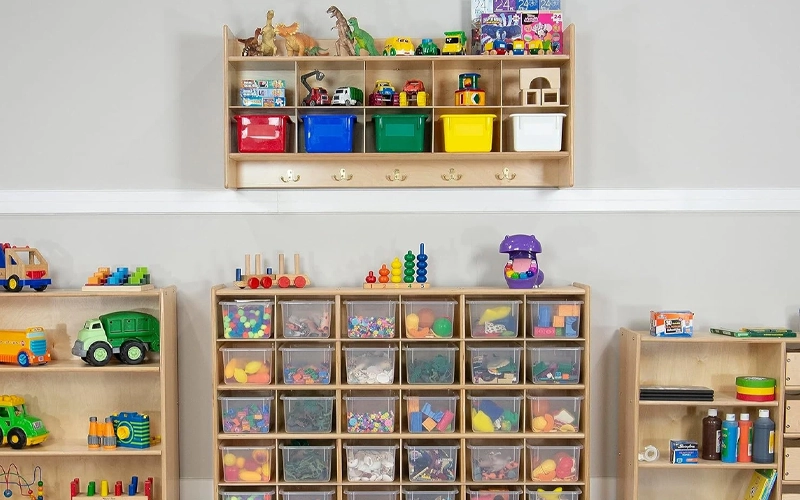

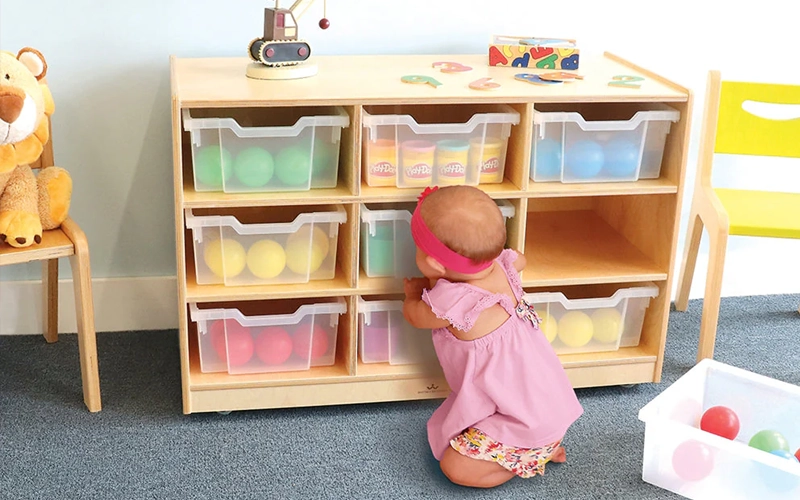
فصلك الدراسي المثالي على بعد نقرة واحدة!
تقسيم الغرفة للعب والتعلم الشامل
يُعدّ تقسيم المناطق ركيزةً أساسيةً لإدارة الفصل الدراسي في بيئة ما قبل المدرسة متعددة الأعمار. فمع تقاسم الأطفال في مراحل نموّ مختلفة المساحة نفسها، يُوفّر تقسيم المناطق الجيد هيكلًا ومساحةً حرّةً. فهو يُقلّل من التحفيز المفرط، ويدعم ضبط النفس، ويضمن مشاركة كلّ طفل - بغض النظر عن عمره - بفعالية في رحلة تعلّمه.
فيما يلي كيفية إنشاء مناطق تدعم الشمولية والاستقلال والتفاعل.
1. مناطق هادئة للتركيز والتنظيم الذاتي
تُعدّ المنطقة الهادئة ملاذًا هادئًا للأطفال الذين يحتاجون إلى استراحة من التحفيز الاجتماعي أو الحسي. تُعد هذه المنطقة بالغة الأهمية في الفصول الدراسية متعددة الأعمار، حيث قد يشعر الأطفال الصغار بالإرهاق، بينما قد يلجأ الأطفال الأكبر سنًا إلى العزلة للتركيز.
العناصر الرئيسية:
- مقاعد ناعمة: أكياس الفاصوليا، أو وسائد الأرضية، أو الأرائك الصغيرة
- يمكن للحواجز البصرية، مثل الأرفف أو الفواصل القماشية، أن تقلل من عوامل التشتيت
- صور مهدئة: ملصقات الطبيعة، أو الإضاءة الناعمة، أو لوحات الألوان الباستيلية
- مجموعة متنوعة من المواد: كتب كرتونية، أدوات مساعدة، زجاجات حسية
تعمل المناطق الهادئة على تعليم الأطفال كيفية التعرف على مشاعرهم وإدارة احتياجاتهم بشكل مستقل.
2. مناطق الحركة والمهارات الحركية الإجمالية
لدى أطفال ما قبل المدرسة رغبة طبيعية في الحركة. وتدعم منطقة الحركة المخصصة هذه الحاجة، خاصةً مع اختلاف مستويات الطاقة حسب العمر.
اقتراحات:
- هياكل التسلق الداخلية أو عوارض التوازن (القائمة على الرغوة والمنخفضة الارتفاع)
- سجادات أرضية للتمدد أو الرقص
- لوحات جدارية بأشكال فيلكرو أو أجزاء متحركة
تدعم هذه المنطقة التطور البدني وتساعد على إعادة توجيه الطاقة الزائدة بطريقة آمنة ومنظمة.
3. مناطق اللعب المفتوحة
اللعب المفتوح هو أساس التعلم المبكر، ويدعم تقسيم الأطفال إلى مناطق مستويات مهارات مختلفة دون فصلهم. تشمل هذه المناطق:
- منطقة البناء: مع مكعبات إسفنجية كبيرة للأطفال الصغار وLEGO/DUPLO لمرحلة ما قبل المدرسة الأكبر سنًا
- منطقة لعب درامية: ملابس تنكرية، ومطابخ لعب، وأدوات دعائية حقيقية مثل الهواتف، أو السماعات الطبية، أو عربات التسوق
- محطات حسية: رمل، ماء، صناديق أرز مع أكواب قياس ومغارف
يتعامل كل طفل مع نفس المواد بطرق مناسبة لنموه، مما يسمح بالنمذجة بين الأقران واللعب المتوازي بشكل طبيعي.
4. مناطق القراءة والمحو الأمية
تعمل هذه المنطقة على تشجيع تطوير اللغة في وقت مبكر وتعزيز حب الكتب لجميع الأعمار.
أساسيات المنطقة:
- كتب لوحية للأطفال الصغار، وكتب مصورة لمرحلة ما قبل المدرسة، وكتب قراءة بسيطة في المراحل المبكرة
- أرفف كتب منخفضة مواجهة للأمام
- الدمى وألواح اللباد وألغاز الأبجدية
- محطة استماع مع قصص صوتية وسماعات رأس (للأطفال الأكبر سنًا)
ويساهم توزيع العناصر الغنية بالقراءة والكتابة في مختلف المناطق أيضًا في تعزيز القراءة باعتبارها جزءًا من كل التعلم، وليس فقط في ركن الكتاب.
5. منطقة الفنون الإبداعية
يجب أن تشمل منطقة الفنون الإبداعية جميع مستويات المهارات الحركية الدقيقة:
- أقلام تلوين وأقلام تحديد سميكة وعصي طلاء للأطفال الصغار
- مقص، غراء، وقوالب للأطفال الأكبر سنًا
- حوامل وصواني على مستوى الطاولة حتى يتمكن العديد من الأطفال من العمل في وقت واحد
احتفظ بالملابس والمناديل وصناديق التنظيف في مكان قريب حتى يتعلم الأطفال كيفية العناية بالمواد بغض النظر عن أعمارهم.
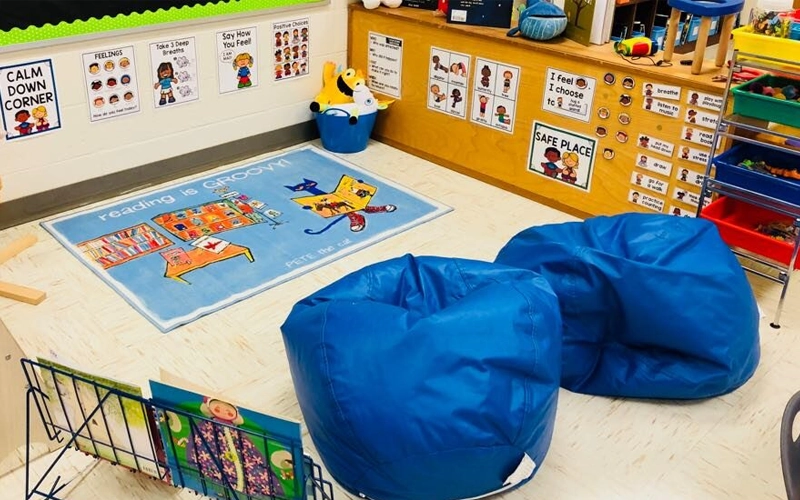
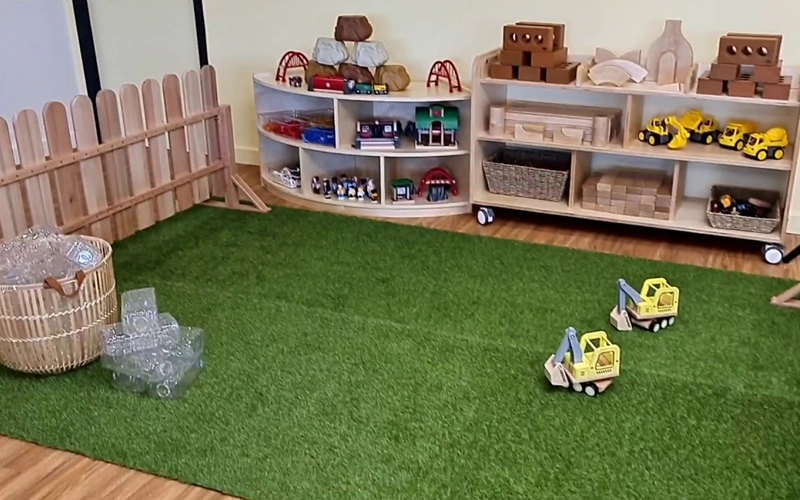
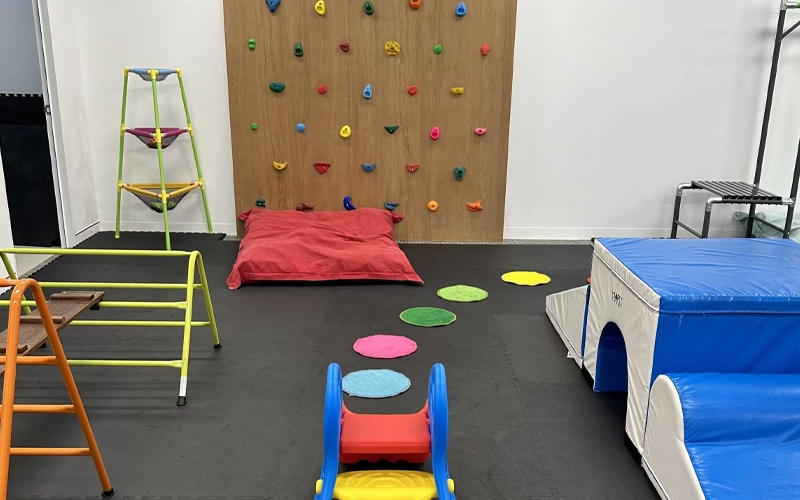
لا تحلم فقط، بل صممه! دعنا نتحدث عن احتياجاتك من الأثاث المخصص!
اختيار المواد عبر العصور
اختيار المواد لفصول دراسية متعددة الأعمار يتطلب موازنة. يجب أن تُناسب المساحة نفسها طفلًا يتعلم تكديس المكعبات وآخر يبدأ بالعد أو القراءة أو بناء أفكار معقدة. يكمن السر في اختيار مواد مفتوحة، ومتدرجة في التعقيد، وآمنة لجميع الفئات العمرية.
إذا تم ذلك بشكل صحيح، فإن اختيار المواد يدعم التعلم المتباين دون فصل الأطفال.
1. ألعاب مفتوحة النهاية تتناسب مع العمر
الألعاب المفتوحة ضرورية في فصول ما قبل المدرسة متعددة الأعمار. فهي مواد ليس لها هدف محدد، مما يسمح للأطفال باستخدامها بطرق تتناسب مع مرحلة نموهم.
وتشمل الأمثلة الأفضل ما يلي:
- كتل:يقوم الأطفال الصغار بالتكديس لتحقيق الاستقرار، بينما يقوم الأطفال الأكبر سنًا في سن ما قبل المدرسة بإنشاء مباني وهياكل خيالية.
- البلاط المغناطيسي:يستكشف الأطفال الصغار الألوان والأشكال، بينما يقوم الأطفال الأكبر سنًا ببناء السيارات أو الحيوانات أو الأنماط الهندسية.
- عجينة اللعب والأجزاء السائبة:تستخدم للضغط والتشكيل من قبل الأطفال الصغار، ولسرد القصص أو النمذجة أو صنع الأنماط من قبل الأطفال الأكبر سنًا.
بفضل هذه المواد، يصبح اللعب مختلفًا بشكل طبيعي دون الحاجة إلى ألعاب منفصلة.
2. كتب تعكس مراحل القراءة المتعددة
توفر منطقة الكتب المجهزة جيدًا تنوعًا في مستوى القراءة والمحتوى:
- كتب كرتونية بصور بسيطة للأطفال الصغار
- كتب قصصية تحتوي على حبكات أساسية وعبارات متكررة لمتعلمي المرحلة المبكرة
- كتب تحتوي على رسوم توضيحية وسرد أكثر تفصيلاً لمرحلة ما قبل المدرسة المتقدمة
إن إضافة الكتب الملموسة أو سلال القصص أو الدعائم السردية تسمح لغير القراء بالتفاعل بشكل عميق مع القصص.
3. أدوات تعليمية متدرجة لمحو الأمية والرياضيات
في الفصول الدراسية لمرحلة ما قبل المدرسة التي تضم أطفالاً من مختلف الأعمار، يتمثل الهدف في توفير نقاط دخول متنوعة إلى مجالات المهارات الأساسية:
- أدوات محو الأمية:
- كتل الأبجدية للتعرف
- بطاقات الأسماء وجدران الكلمات للقراء المبتدئين
- مجموعات الحروف المغناطيسية وبناء الكلمات للأطفال الأكبر سنًا في سن ما قبل المدرسة
- مواد الرياضيات:
- عد الدببة أو خيوط الخرز لفهم الأرقام
- ألعاب لوحية بسيطة لتعليم التسلسل والكمية
- بطاقات الأنماط وأدوات القياس لمرحلة STEM المبكرة
يمكن للمعلمين إنشاء نفس المركز مع أدوات لمستويات متعددة من المهارات - حيث يختار الأطفال أنفسهم بناءً على استعدادهم.
4. التعقيد الآمن والخاضع للإشراف
بعض المواد - مثل المقصات، والألغاز الصغيرة، ومجموعات تنمية المهارات الحركية الدقيقة - تتطلب إشرافًا. في الفصول الدراسية المختلطة:
- يتم وضع هذه العناصر على أرفف أعلى أو تخزينها في المناطق التي يقودها المعلم
- يتم منح الوصول بناءً على استعداد الطفل ومعرفته بالأداة
- يقوم المعلمون بنمذجة الاستخدام وتوجيهه، مما يخلق فرص التعلم والثقة
يساعد هذا في الحفاظ على السلامة دون استبعاد الأطفال القادرين من المهام الصعبة.
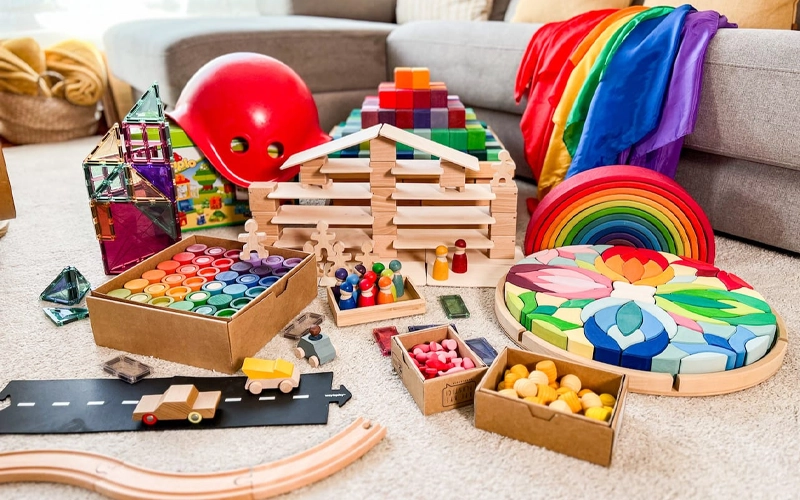
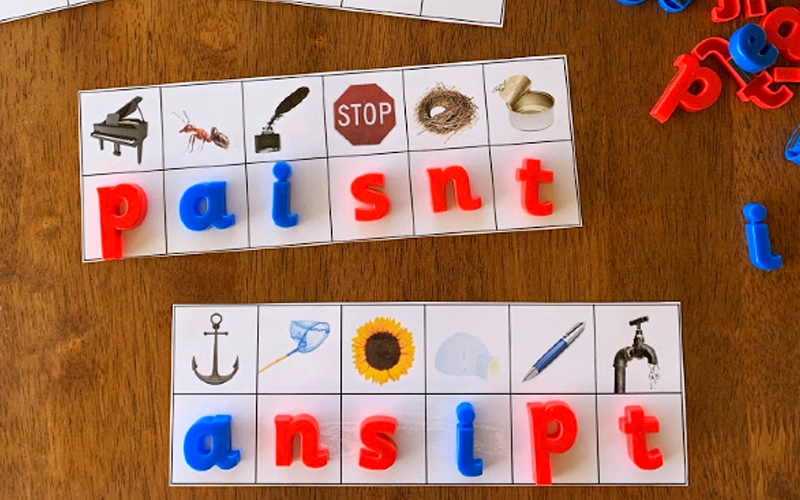

الإضاءة والصوتيات والنغمة العاطفية
لا تقتصر بيئة فصول ما قبل المدرسة متعددة الأعمار على الأثاث والمواد. فالإضاءة والصوت والجو العام يؤثران بشكل كبير على مشاعر الأطفال ومستويات طاقتهم وسلوكهم. في الفصول الدراسية التي يتعلم فيها الأطفال من مختلف مراحل نموهم معًا، يجب التخطيط لهذه العناصر الحسية بعناية أكبر لخلق الراحة والترابط.
1. الضوء الطبيعي يدعم المزاج والانتباه
يؤدي التعرض لضوء النهار إلى تحسين الحالة المزاجية والتركيز وأنماط النوم، وهو أمر مهم بالنسبة للأطفال في سن ما قبل المدرسة الذين لا تزال أجسامهم في مرحلة بناء إيقاعاتها اليومية.
- إعطاء الأولوية للنوافذ الكبيرة والضوء الطبيعي غير المعوق عندما يكون ذلك ممكنا.
- استخدم ستائر شفافة لتوزيع الوهج دون حجب السطوع.
- إذا كان الضوء الطبيعي محدودًا، استثمر في إضاءة LED ذات الطيف الكامل والتي تحاكي ضوء النهار وتقلل من الضغط.
قم بتنظيم مناطق ذات تركيز عالٍ (مثل طاولات القراءة أو المشاريع) بالقرب من النوافذ للاستفادة من الإضاءة الطبيعية التي تبعث على الهدوء.
2. إضاءة متعددة الطبقات لأنشطة متنوعة
نظرًا لأن الفصول الدراسية متعددة الأعمار متعددة الوظائف، فإن الإضاءة المرنة ضرورية:
- استخدم أضواء علوية قابلة للتعتيم للانتقال بين اللعب النشط والوقت الهادئ.
- قم بتثبيت مصابيح المهام أو مصابيح الطاولة المنخفضة في المناطق الهادئة وزوايا القراءة للحصول على أجواء مريحة ومركزة.
- استخدم الإضاءة المميزة لتسليط الضوء على العروض أو المواد، مما يخلق اهتمامًا بصريًا دون الإفراط في التحفيز.
تساعد مستويات الإضاءة المختلفة الأطفال على ربط مساحات محددة بسلوكيات معينة، مثل الهدوء، والتركيز، والنشاط، أو النشاط الاجتماعي.
3. التصميم الصوتي للتركيز والانسجام
الأطفال الصغار حساسون للضوضاء. وبدون تخطيط صوتي، قد تسود الفوضى في الفصول الدراسية المختلطة الأعمار بسرعة.
وتشمل الاستراتيجيات ما يلي:
- المواد الناعمة (السجاد والستائر والأثاث المبطن) لامتصاص الصوت
- ألواح الجدران المصنوعة من الفلين أو اللباد لتقليل الصدى
- بلاط السقف الصوتي في الغرف الكبيرة
- استخدم أجهزة الضوضاء البيضاء أو موسيقى خلفية لطيفة لإخفاء الأصوات المزعجة أثناء الانتقالات.
استخدم الأثاث لتحديد مناطق الصوت - مناطق هادئة للقراءة، ومناطق صاخبة للعب الدرامي. هذا يُعلّم الأطفال ضبط أنفسهم بناءً على توقعات كل منطقة.
4. علم نفس الألوان والإشارات البصرية
تؤثر الألوان على المشاعر. فبينما تُحفّز الألوان الزاهية الطاقة، إلا أنها قد تُرهق الأطفال الصغار أو تُشتّت انتباه من يحتاجون إلى الهدوء.
في الفصول الدراسية متعددة الأعمار:
- استخدمي درجات الألوان الأرضية المحايدة أو الناعمة للجدران والأثاث الكبير لإنشاء خلفية هادئة ومتوازنة.
- أضف لمسات من الألوان في مناطق التعلم (على سبيل المثال، سجادة زرقاء لامعة في منطقة الكتل) لتحديد المساحة وإثارة الاهتمام.
- تجنب الإفراط في التحفيز - حدد الأنماط المزدحمة، أو الفوضى البصرية، أو ديكورات الجدران المفرطة.
- استخدم الإشارات الرمزية، مثل آثار الأقدام على الأرض، لمسارات الحركة أو الإطارات الناعمة لتسليط الضوء على العروض الرئيسية بصريًا.
الهدف هو مساعدة الأطفال على فهم المساحة بصريًا دون الحاجة إلى شرح لفظي - وهي استراتيجية مفيدة للأطفال الصغار أو متعلمي اللغة الإنجليزية كلغة ثانية.
تحقيق التوازن بين السلامة والإبداع في الفصول الدراسية متعددة الأعمار
تصميم فصل دراسي لمرحلة ما قبل المدرسة متعدد الأعمار يتطلب التوفيق بين تشجيع الاستكشاف وضمان السلامة. فمع تواجد الأطفال الصغار والكبار في بيئة واحدة، يجب أن يشجع كل ركن على الإبداع دون المساس بسلامتهم.
1. معايير السلامة المناسبة للعمر
الأطفال الصغار أكثر عرضة للمخاطر، كالأشياء الصغيرة، والأثاث غير المستقر، والأسطح المرتفعة. في فصول ما قبل المدرسة متعددة الأعمار، يجب تعزيز السلامة على عدة مستويات:
- استخدم فقط الأثاث غير السام ذو الحواف المستديرة
- تأكد من تثبيت الأرفف على الجدران وعدم انقلابها بسهولة
- تجنب الأشياء الصغيرة التي يمكن للأطفال الصغار الوصول إليها في المناطق التي يسهل الوصول إليها
- توفير مناطق مخصصة لكل عمر للمواد الأكثر خطورة مثل المقص أو مسدسات الغراء، تحت إشراف المعلم
إن التصميم من أجل السلامة لا يعني إزالة التحديات، بل يعني إدارة المخاطر لتعزيز الثقة والمسؤولية والاستقلالية.
2. تشجيع المخاطرة من خلال الاستكشاف الآمن
ينمو الإبداع والابتكار عندما يشعر الأطفال بحرية التجربة. في الفصول الدراسية المختلطة، قد يبدو هذا كالتالي:
- يقوم الأطفال الأكبر سنًا ببناء أبراج طويلة من الكتل، بينما يستكشف الأطفال الصغار التوازن باستخدام أشكال رغوية أصغر حجمًا
- منطقة فنية فوضوية حيث يقوم الأطفال الصغار بالرسم بأصابعهم، بينما يعمل الأطفال الأكبر سنًا على إنشاء صور مجمعة مفصلة
- يتم استخدام المواد الطبيعية مثل العصي والصخور والأوراق بشكل مختلف من قبل الأشخاص من مختلف الأعمار
إن توفير الحرية المنظمة يمنح الأطفال الثقة للاستكشاف دون خوف - وهو عنصر أساسي في تنمية الطفولة المبكرة.
3. تعليم التفاعل الآمن بين الأقران
تشمل السلامة أيضًا كيفية تفاعل الأطفال مع بعضهم البعض. تحتاج الفصول الدراسية المختلطة إلى قواعد واضحة لما يلي:
- مشاركة الأدوات والمواد بشكل عادل
- احترام المساحة الشخصية أثناء اللعب عالي الطاقة
- المساعدة دون السيطرة - قد يرغب الأطفال الأكبر سنًا في "العمل من أجل" بدلاً من "المساعدة في"
ويقوم المعلمون بنمذجة هذه السلوكيات والتوجيه عند الحاجة، مما يخلق ثقافة التعاطف والمسؤولية عبر الخطوط العمرية.
4. تدوير المواد مع وضع التطوير في الاعتبار
ما هو آمن ومحفز لمجموعة قد لا يناسب أخرى. ينبغي على المعلمين تدوير المواد الدراسية بانتظام بناءً على:
- السلوك الملاحظ: على سبيل المثال، إذا استمر الأطفال الصغار في وضع القطع في أفواههم، قم بإزالتها أو استبدالها
- تقدم المهارات:عندما يكبر الأطفال ويتغلبون على بعض الألغاز، قدم لهم ألغازًا أكثر تقدمًا
- المواضيع الموسمية أو أعمال المشاريع: مواءمة المواد مع الاهتمامات الحالية مع الحفاظ على السلامة
يضمن التدوير مشاركة الأطفال ويضمن نمو الفصل الدراسي معهم، دون المساس بالهيكل أو النظام.
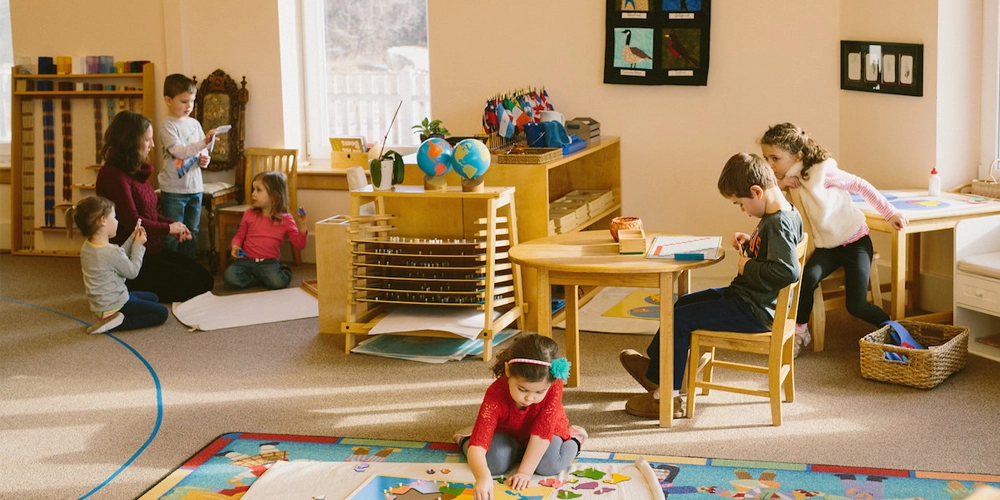
ربط الرؤية والتنفيذ في تصميم الفصول الدراسية متعددة الأعمار
يبدأ تصميم فصل دراسي متعدد الأعمار بمبادئ أساسية - تقسيم المناطق، والانسيابية، والطابع العاطفي - إلا أن تجسيد هذه الأفكار يتطلب حلولاً عملية وعملية. بمجرد أن تتضح الرؤية، يحين وقت التركيز على الأدوات والمواد وميزات التصميم التي تجعل التعلم اليومي سلسًا وقابلًا للتطوير عبر الفئات العمرية.
في القسم التالي، ننتقل من أطر التخطيط إلى استراتيجيات التنفيذ، ونشارك خيارات محددة للأثاث، وأساليب التخزين، وتحسينات التصميم التي تدعم فصول ما قبل المدرسة الواقعية. سواءً كنتم تبدؤون من جديد أو تُحدّثون مساحةً قائمةً لأعمار مختلفة، ستساعدكم هذه النصائح العملية على تحويل النظرية إلى تطبيق عملي، مع ضمان بقاء المرونة والسلامة والتعلم الذي يقوده الطفل في صميم الموضوع.
حلول عملية لإضفاء الحيوية على فصلك الدراسي متعدد الأعمار
أثاث مرن ينمو مع الأطفال
في الفصول الدراسية لمرحلة ما قبل المدرسة التي تضم أطفالاً من مختلف الأعمار، يجب أن يتكيف الأثاث مع نمو أجسام الأطفال وتطور مهاراتهم الذين تتراوح أعمارهم بين 2.5 إلى 5 سنوات. وإليك كيفية بناء المرونة:
- طاولات وكراسي قابلة للتعديل يمكن رفعها أو خفضها مع نمو الأطفال، مما يضمن الراحة والوضعية الصحيحة على مر السنين.
- كراسي قابلة للتكديس وخفيفة الوزن وسهلة الحركة لأيدي الأطفال الصغار، ولكنها متينة بما يكفي للأطفال الأكبر سنًا في سن ما قبل المدرسة.
- محطات عمل قابلة للتحويل: طاولات تنضم للمهام التعاونية ولكنها منفصلة للعمل الفردي الهادئ أو في مجموعات صغيرة.
- تتيح الوحدات المتنقلة ذات العجلات القابلة للقفل إعادة تكوين تخطيط الفصل الدراسي على مدار العام، مما يعزز الأنشطة المتنوعة.
- مواد طويلة الأمد ومناسبة لمرحلة ما قبل المدرسة ذات زوايا مستديرة وأسطح متينة يمكنها تحمل سنوات من الاستخدام.
يقلل هذا الإعداد المرن من الحاجة إلى استبدال الأثاث بشكل متكرر ويدعم الاستخدام المريح والمناسب للعمر طوال دورة حياة الفصل الدراسي.
أدوات التخزين والتخطيط التي تدعم احتياجات الأعمار المختلفة
يُساعد التخزين الكافي الأطفال من جميع الأعمار على الوصول إلى المواد الدراسية باستقلالية وفهم التوقعات. استخدم هذه الأدوات للحفاظ على تنظيم الفصل الدراسي وتمكينه:
- رفوف متعددة الارتفاعات: أرفف منخفضة (<60 سم) للأطفال الصغار وأرفف متوسطة المستوى لمرحلة ما قبل المدرسة الأكبر سنًا.
- صناديق شفافة ومفتوحة حتى يتمكن الأطفال من التعرف بصريًا على ما بداخلها - دون الحاجة إلى القراءة.
- العلامات المرئية القائمة على الأيقونات بالإضافة إلى الكلمات البسيطة لتعزيز معرفة القراءة والكتابة في وقت مبكر مع مساعدة الأطفال في العثور على المواد وإعادتها.
- عربات التخزين المتنقلة للمواد مثل الأدوات اليدوية أو الأدوات الفنية - يمكن نقلها بسهولة إلى مناطق التعلم المختلفة.
- "روتينات التخزين" المنظمة، مثل أغاني التنظيف اليومية والمساعدين من الأقران، تعزز المهارات التنظيمية وملكية الفصل الدراسي.
تعمل هذه الأدوات على تعزيز الاستقلال وتبسيط عملية التنظيف والمساعدة في الحفاظ على بيئة متعددة الطبقات تناسب مراحل النمو المختلفة.
تحسينات التصميم لتحسين الحالة المزاجية والسلامة والتدفق
ولإنشاء مساحة تدعم التعلم المشترك بشكل حقيقي، ركز على هذه الترقيات البيئية:
- مسارات محددة استخدام السجاد أو شريط الأرضيات لتوجيه الحركة وتقليل نقاط الاصطدام أثناء الانتقالات.
- إضاءة مزاجية:تركيبات قابلة للتعتيم مع مصابيح LED ذات الطيف الكامل للتكيف مع نوع النشاط - اللعب الاجتماعي، أو العمل المركّز، أو التأمل الهادئ.
- التوازن الصوتي:تساعد السجادات، والألواح الماصة للصوت، والمقاعد الناعمة في إدارة الضوضاء دون عزل التواصل.
- تقسيم المناطق اللونية:جدران محايدة مع لمسات متعمدة من الألوان في مناطق مميزة - على سبيل المثال، اللون الأزرق حول منطقة القراءة، والأخضر بالقرب من الإمدادات الحسية.
- تصميم تدفق السلامة:تتيح حواف الأثاث المستديرة والأرفف المثبتة على الحائط وخطوط الرؤية الواضحة إمكانية الإشراف وتقليل الحوادث.
من خلال تحقيق التوازن بين الجماليات والنغمة العاطفية والسلامة الجسدية، تعمل هذه التحسينات على خلق بيئة متماسكة وداعمة للتعلم بين مختلف الأعمار.
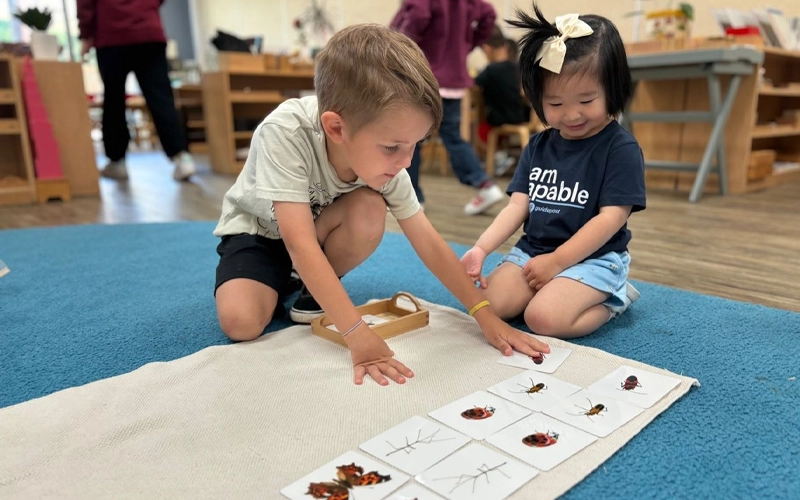

خاتمة
إن تصميم وإدارة فصول دراسية متعددة الأعمار لمرحلة ما قبل المدرسة ليس مجرد توجه، بل هو فلسفة تعليمية فعّالة، تُنمّي، عند تطبيقها جيدًا، القيادة والتعاطف والتعلم الفردي لدى كل طفل. من خلال فهم القيم الأساسية لفصول ما قبل المدرسة متعددة الأعمار، وتبني فوائدها، والتعامل مع تحدياتها بشكل استباقي، يمكن للمعلمين وقادة المدارس إنشاء مساحات متجاوبة مع نمو الأطفال وداعمة عاطفيًا.
من اختيار أثاث مرن يتناسب مع نمو الأطفال، إلى تطبيق حلول تخزين استراتيجية، وتحسين تفاصيل البيئة كالإضاءة والصوت والألوان، يُسهم كل عنصر في خلق مساحة مثالية يزدهر فيها الأطفال من مختلف الأعمار جنبًا إلى جنب. هذه الفصول الدراسية لا تُسهم فقط في بناء مجتمع، بل تُشجع على الإرشاد والتوجيه، وتعكس عالمًا متنوعًا بين الأجيال سيعيشه الأطفال يومًا ما.
سواءً كنتَ تصمم مركزًا جديدًا أو تُحسّن مركزًا قائمًا، فإنّ رحلة بناء فصل دراسي عملي ومُلهم لمختلف الأعمار تبدأ بتخطيط مدروس وخيارات عملية. كلّ قرار - من ارتفاع الرفوف إلى تصميم المساحات - هو فرصة لتعزيز الاستقلالية والفضول والتعاون.
ومن خلال اتباع الحلول والمبادئ العملية التي تمت مشاركتها في هذا الدليل، فإنك لا تدير تنوع الأعمار فحسب، بل تستفيد منه أيضًا لتحويل التعلم المبكر إلى شيء أكثر ثراءً وعمقًا وإنسانية.
الأسئلة الشائعة
1. ما هو الفصل الدراسي متعدد الأعمار في مرحلة ما قبل المدرسة؟
يضم الفصل الدراسي متعدد الأعمار أطفالًا يمتدون في نطاق عمري يتراوح من 2 إلى 3 سنوات (على سبيل المثال، من سن 2 إلى 5 سنوات)، ويتم تجميعهم بشكل مقصود لتعزيز التعلم بين الأقران والتقدم المناسب من حيث النمو.
2. لماذا نختار مجموعات أعمار مختلطة لمرحلة ما قبل المدرسة؟
تساعد البيئات ذات الأعمار المختلطة الأطفال الأصغر سنًا على التعلم من خلال الملاحظة، وتمنح الأطفال الأكبر سنًا أدوارًا قيادية تعزز الثقة والتعاطف.
3. هل سيشعر الأطفال الأكبر سناً بالملل عند تجميعهم مع أطفال أصغر سناً؟
إطلاقًا. صُممت الفصول الدراسية بمواد ومحطات متدرجة، حيث يعمل الأطفال الأكبر سنًا وفقًا لمستواهم، بينما ينخرط الصغار في نسخ أبسط. يدعم هذا الهيكل الإثراء المتباين.
4. كيف يتم تجميع الأطفال في مجموعات متعددة الأعمار؟
يُصنَّف الأطفال بمرونة حسب استعدادهم التنموي، أو اهتماماتهم المشتركة، أو مستويات مهاراتهم، وليس حسب العمر فقط. هذا يُحسِّن المشاركة ويُقدِّم تحدٍّ مناسب لكل طفل.
5. كيف يؤثر تقسيم الطلاب إلى مجموعات متعددة الأعمار على بيئة الفصل الدراسي؟
تُظهر الأبحاث أن ذلك يُنشئ جوًا أكثر شمولًا وأقل تنافسية. يُكوّن الأطفال روابط إرشادية، ويتحسن تقديرهم لذاتهم، وتقوى صحتهم النفسية بفضل تقليل مقارنة الأقران.
6. هل هناك حاجة إلى تغيير مؤهلات المعلمين؟
نعم. للتعامل بفعالية مع احتياجات النمو المتنوعة، يجب أن يتمتع المعلمون بمهارات التقييم بالملاحظة، والتمييز الاستجابي، وإدارة السلوك.
7. ما هي المدة التي يبقى فيها الأطفال في فصول ما قبل المدرسة متعددة الأعمار؟
تستخدم معظم البرامج حلقات مدتها من سنتين إلى ثلاث سنوات، حيث يظل الأطفال مع نفس المعلم ومجموعة الأقران، مما يعزز الاستقرار وعمق العلاقة.
8. هل هناك أي مخاوف للوالدين؟
تتعلق المخاوف الشائعة بمدى قدرة الأطفال الصغار على مواكبة التطور، أو ما إذا كان الأطفال الأكبر سنًا سيواجهون تحديات. يمكن معالجة هذه المخاوف بشرح كيفية موازنة المواد، والإرشاد من الأقران، ودعم المعلمين، بين هذه الاختلافات النمائية.
9. هل يتأثر التقدم الأكاديمي مقارنة بالفصول الدراسية التقليدية؟
تشير الدراسات إلى أن أداء الأطفال في الفصول الدراسية المختلطة الأعمار أكاديميًا مساوٍ أو أفضل. يدعم هذا النموذج التمايز، والتعليم بين الأقران، والتطوير الذاتي.

